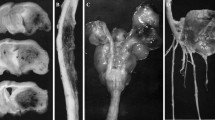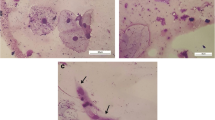Abstract
Through recent research, the trace element, germanium, was found to have an anticancer effect. The purpose of this research was to determine the effect of germanium on 1, 2-dimethylhydrazine-induced intestinal cancer in rats. Ninety-six 8-week-old Sprague-Dawley male rats were divided into 4 groups, with 24 rats in each group. All received dimethylhydrazine, 20 mg/kg body weight, subcutaneously, once a week for 20 weeks. Except for one control group, the other three groups were subdivided into six groups and administered three different kinds of germanium (inorganic germanium, organic germanium, and natural organic germanium) one month before and during dimethylhydrazine treatment, and during dimethylhydrazine treatment, respectively. Twenty-four weeks after carcinogen exposure, all surviving animals were sacrificed and examined for intestinal tumors. The number and location of the tumors were recorded and the pathology examined. The incidence of intestinal cancer in the control group (dimethylhydrazine only) was 91 percent; in groups provided with inorganic germanium one month before and during dimethylhydrazine treatment, and during dimethylhydrazine treatment only, it was 91 and 78 percent; in groups provided with organic germanium one month before and during dimethylhydrazine treatment, and during dimethylhydrazine treatment only, it was 64 and 64 percent; in groups provided with natural organic germanium one month before and during dimethylhydrazine treatment and during dimethylhydrazine treatment only, it was 50 and 45 percent. From these results, the authors conclude that natural organic germanium has the best prevention effect for intestinal cancer in this animal model (P<0.01), followed by organic germanium (P <0.05). Inorganic germanium has no effect. However, there is no difference in the cancer prevention effect of germanium provided one month before and during dimethylhydrazine treatment, and during dimethylhydrazine treatment only.
Similar content being viewed by others
References
Kumano N, Ishikawa T, Koinumaru S, et al. Antitumor effect of the organogermanium compound Ge-132 on the Lewis lung carcinoma (3LL) in C57 BL/6 (B6) mice. Tohoku J Exp Med 1985;146:97–104.
Sato H, Iwaguchi T. Antitumor effect of a novel organogermanium compound, G-132, Jap J Cancer Chemother 1979;6:79–83.
Saiers JH, Slavik M, Stephens RL, Crawford ED. Therapy for advanced renal cell cancer with spirogermanium: a southwest oncology group study. Cancer Treat Rep 1987;71:207–8.
Falkson G, Falkson HC. Phase II trial of spirogermanium for treatment of advanced breast cancer. Cancer Treat Rep 1983;67:189–90.
Goodwin JW, Crowley J, Tranum B, et al. Phase II trial of spirogermanium in central nervous system tumors: a southwest oncology group study. Cancer Treat Rep 1987;71:99–100.
Suzuki F, Brutkiewicz RR, Pollard RB. Ability of sera from mice treated with Ge-132, an organic germanium compound, to inhibit experimental murine ascites tumors. Br J Cancer 1985;52:757–63.
Dimartino MJ, Lee JC, Badger AM, Muirhead KA, Mirabelli CK, Hanna N. Antiarthritic and immunoregulatory activity of spirogermanium. J Pharmacol Exp Ther 1986;236:103–10.
Hachisu M, Takahashi H, Koneda T, Sekizawa Y. Analgesic effect of novel organogermanium compound Ge-132. J Pharm Dyn 1983;6:814–20.
Sato R, Ishikawa A. Effect of carboxyethylgermanium sesquioxide on the blood pressure of the spontaneous hypertension rats (SHR), Kiso-to-Rinsho. 1973;7:105–12.
Asai K. Miracle cure: organic germanium. Tokyo: Japan Publications, 1980.
Oikawa H, Kakimoton N. Syntheses of B-trichlorogermyl derivatives. Proceedings 21st Annual Meeting of Jap Chem Soc 1968:1946.
Tsutsui M, Kakimoto N, Axtell DD, Oikawa H, Asai K. Crystal structure of carboxyethylgermanium sesquioxide. J Am Chem Soc 1976;98:8287–9.
Rosenberg B, Van Camp L, Krigas T. Inhibition of cell division inEscherichia coli by electrolysis products from a platinum electrode. Nature 1965;205:698–9.
Bower JR, Gale GR, Gardner WA Jr, et al. Cis-dichlorodiammineplatinum (II): suppression of adjuvant-induced arthritis in rats. Agents Actions 1974;4:108–12.
Mirabelli CK, Crooke ST. Pharmacology of auranofin—a review and future perspectives. In: Capell HA, Cole DS, Manghani KK, Morris RW (eds). Auranofin. Amsterdam: Excerpta Medica, 1983:17–31.
Walz DT, Dimartino MJ, Chakrin LW, et al. Antiarthritic properties and unique pharmacologic profile of a potential chrystotherapeutic agent: SK and FD-30162. J Pharmacol Exp Ther 1976;197:142–52.
Bedikian AY, Valdivieso M, Bodey GP, et al. Phase I clinical studies with gallium nitrate. Cancer Treat Rep 1978;62:1449–53.
Aso H, Suzuki F, Yamaguchi T, Hayashi Y, Ebina T, Ishida N. Induction of interferon and activation of NK cells and macrophages in mice by oral administration of Ge-132, an organic germanium compound. Microbiol Immunol 1985;239:65–74.
Suzuki F, Pollard RB. Prevention of suppressed interferon gamma production in thermally injured mice by administration of a novel organogermanium compound, Ge-132. J Interferon Res 1984;4:223–33.
Suzuki F, Brutkiewicz RR, Pollard RB. Cooperation of lymphokine and macrophages in expression of antitumor activity of carboxyethylgermanium sequioxide, (Ge-132). Anticancer Res 1986;6:177–82.
Suzuki F, Brutkiewicz RR, Pollard RB. Importance of T-cells and macrophages in the antitumor activity of carboxyethylgermanium sequioxide, (Ge-132). Anticancear Res 1985;5:479–84.
Mizushima Y, Shoji Y, Kaneko K. Restoration of impaired immunoresponse by germanium in mice. Int Arch Allergy Appl Immunol 1980;63:338–9.
Rice L, Wheeler JW, Geschickter CF. Spirans XXII: synthesis of 4,4-dialkyl-4-germacyclohexanone and 8,8-dialkyl-8-germaazaspiro (4,5) decanes. J Heterocycl Chem 1974;11:1041–7.
Steele G Jr, Crissey M, Gittes R, Harte P, Wilson R, Corson J. Potentiation of dimethylhydrazine bowel carcinogenesis in rats. Canccer 1981;47:2218–21.
Nagata N, Yoneyama T, Yanagida K, et al. Accumulation of germanium in the tissues of a long-term user of germanium preparation dead of acute renal failure. J Toxicol Sci 1985;10:333–41.
Tomizawa S, Suguro N, Kagoshima M. Studies on general pharmacological effects of some germanium compounds. Pharmacometrics 1978;16:671–82.
Nagata T, Nagata T, Aramaki Y, Enomoto M, Isaka H, Otsuka J. Chronic toxicity study of intravenously administered carboxyethylgermanium sesquioxide in beagle dogs. Pharmacometrics 1978;16:613–36.
Miyao K, Onishi T, Asai K, Tomizawa S, Suzuki F. Toxicology and phase I studies on a novel organogermanium compound, G-132. Curr Chemother Inf Dis (proceedings of the 11th ICC and 19th ICAAC, American Society for Microbiology) 1980;2:1527–9.
Chiang HC, Wann MH. Improved method of assay of germanium in crude drugs. J Taiwan Pharm Assoc 1986;38:189–98.
Friedman RM. Antitumor effects of interferons. J Exp Pathol 1987;3:203–27.
Smyth JF, Balkwill FR, Cavalli F, et al. Interferons in oncology: current status and future directions. Eur J Cancer Clin Oncol 1987;23:887–9.
Lemmel EM, Franke M, Gaus W et al. Results of a phase II clinical trial on treatment of rheumatoid arthritis with recombinant interferon-gamma. Rheumatol Int 1987;7:127–32.
Goodman S. Therapeutic effects of organic germanium. Med Hypotheses 1988;26:207–15.
Ohotta T. Germanium may decrease the cancer incidence. Tokyo: Asu Books, 1984:42–55.
Warburg O. The prime cause and prevention of cancer: Lindau lecture. Wurzburg, Germany: K Triltsch, 1966.
Kamen B. Germanium: a new approach to immunity. Larkspur: Nutrition Encounter, 1987.
Marcznski B. Carcinogenesis as the result of the deficiency of some essential trace elements. Med Hypotheses 1988;26:239–49.
Jacobs MM. Selenium inhibition of 1,2-dimethylhydrazine-induced colon carcinogenesis. Cancer Res 1983;43:1646–9.
Author information
Authors and Affiliations
Additional information
Read at the XIIth Biennial Congress of the International Society of University Colon and Rectal Surgeons, Glasgow, Scotland, July 10 to 14, 1988.
Supported by a grant from the National Science Council, Republic of China [NSC76-0412-B016-29].
About this article
Cite this article
Jao, SW., Lee, W. & Ho, YS. Effect of germanium on 1, 2-dimethylhydrazine-induced intestinal cancer in rats. Dis Colon Rectum 33, 99–104 (1990). https://doi.org/10.1007/BF02055535
Issue Date:
DOI: https://doi.org/10.1007/BF02055535




